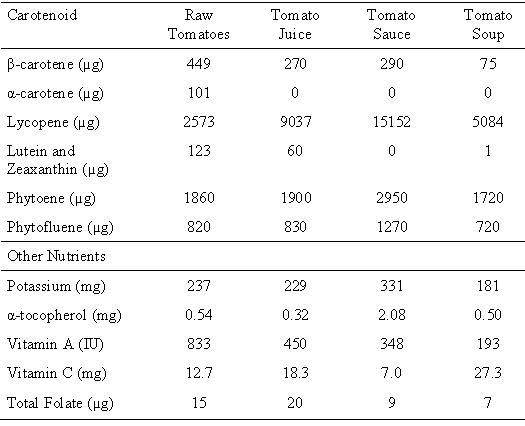Plants are known to contain a wide variety of biologically active phytochemicals that may have important health benefits in humans. Carotenoids are one group of phytochemicals that have been shown to protect from degenerative diseases such as cancer. Carotenoids are though to prevent cancers in a number of ways including via antioxidant defence, by improving cell to cell communication by increasing gap junctions and by modulation of cell-cycle progression. Some specific carotenoids appear to display protective effects against specific diseases. For example, evidence is mounting that consumption of tomatoes is able to reduce the risk of developing prostate cancer. Research suggests that this protective effect on the prostate gland from consumption of tomatoes is due to the presence of the carotenoid lycopene within the fruit. Lycopene is partly responsible for the red colour of tomatoes.
Tomatoes are an important fruit nutritionally because they are consumed in such high quantities in Western nations. In addition, tomatoes are processed into a number of frequently eaten tomato foods. While consumption of whole raw fruits might seem the obvious way to obtain protective levels of carotenoids from tomatoes, research suggest that some carotenoids survive processing and therefore are present in high levels in manufactured foods. In fact, lycopene may even become concentrated in certain processed foods, implying that raw tomatoes are not the best source of carotenoid protection from prostate cancer. Tomato sauce, tomato soup and tomato juice have higher levels of lycopene than the same weight of raw tomatoes (figure 1). However, processing appears to decrease levels of other carotenoids such as α-carotene, β-carotene, lutein and zeaxanthin.
Figure 1. The nutrient content of raw tomatoes and tomato products (per 100g)1
Tomatoes are also good sources of other nutrients including potassium, vitamin A, vitamin C, α-tocopherol and folate. In addition, raw tomatoes contain dietary fibre, and fibre is also present in some processed products such as tomato paste. The flavonols quercetin and kaempferol are present in high concentrations in the skins of tomatoes, making up over 98 % of the total flavonols present. Naringenin is a flavanone also present in tomato skin in small quantities. Flavonols and flavanones are thought to possess antioxidant properties in humans. The combination of nutrients in tomatoes makes for a healthy choice of food for those wishing to protect themselves from degenerative disease. Eating raw tomatoes is an excellent way to increase intake of a number of carotenoids and other beneficial nutrients. However, it would appear that similar levels of protection may be available to those who consume tomato products following processing.
RdB

